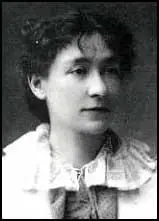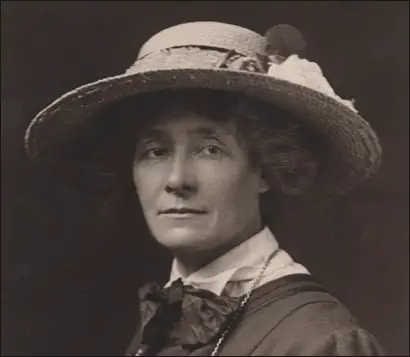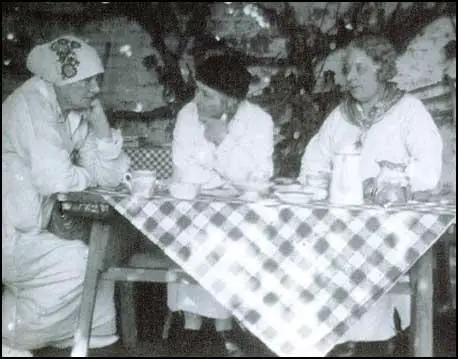Edith Craig

Edith Ailsa Geraldine Craig was born on 9th December 1869. Her parents, Edward William Godwin, an architect, and Ellen Terry, an actress, had eloped the previous year.
After her separation from Godwin in 1875, Ellen Terry was primary carer for Edith Craig and her brother Edward Craig. She was educated at Mrs Cole's school, a co-educational institution in Foxton Road, Earls Court and the Royal Academy of Music.
Craig became interested in the subject of women's suffrage after meeting Elizabeth Malleson when she was a child. She later recalled: "When I was at school I lived in a house of Suffrage workers, and at regular periods the task of organising Suffrage petitions kept everybody busy. Perhaps I didn't think very deeply about it, and my first ideas of Suffrage duties were concerned with the interminable addressing of envelopes; but I certainly grew up quite firmly certain that no self-respecting woman could be other than a Suffragist."
With the help of her mother she worked for the Lyceum Theatre company, designing costumes and acting under the stage name of Ailsa Craig and in 1895 appeared with Henry Irving in The Bells and Bygones, a play by Arthur Wing Pinero. Her performances were praised by George Bernard Shaw and later that year she made her first tour of America.
Craig lived with the writer Christabel Marshall from 1899, when the two women shared a flat at 7 Smith Square, London. Despite her acting success, Edith Craig decided to start a business producing costumes for several London theatre productions. In 1902–3 she collaborated with the artist Pamela Colman Smith on the design of scenes for Where there is Nothing a play by W. B. Yeats. According to her biographer, Katharine Cockin: "Craig was an active member of several significant theatre societies which produced experimental drama in London; some of them directly challenged the lord chamberlain's regulation of the stage: the Independent Theatre; the Stage Society; the Masquers; the Pioneer Players; the Phoenix Society; and the Renaissance Theatre Society."
Ellen Terry claimed: "She (Edith Craig) loathes emotional people, yet adores me. I scarcely ever dare kiss her, and I'm always dying to, but she hates it from anyone." Christabel Marshall added: "I often felt that I had not the faintest notion of what was going on in her mind and heart and soul. She seldom talked about herself; she was as reticent on that subject as she was frank and explicit on others."
Edith Craig joined the Women's Social and Political Union and in 1908, some of the members formed the Actresses' Franchise League. Craig joined this group that at this time included Elizabeth Robins, Kitty Marion, Winifred Mayo, Sime Seruya, Inez Bensusan, Ellen Terry, Lillah McCarthy, Sybil Thorndike, Lena Ashwell, Lily Langtry and Nina Boucicault.
The first meeting of the Actresses' Franchise League took place at the Criterion Restaurant at Piccadilly Circus. The AFL was open to anyone involved in the theatrical profession and its aim was to work for women's enfranchisement by educational methods, selling suffrage literature and staging propaganda plays. The AFL neither supported nor condemned militancy.
Inez Bensusan oversaw the writing, collection and publication of AFL plays. Pro-suffragette plays written by members of the Women Writers Suffrage League and performed by the AFL included the play How the Vote was Won by Cicely Hamilton and Votes for Women by Elizabeth Robins. Another play by Hamilton, A Pageant of Great Women, was directed by Edith Craig. She also acted in several of these plays.
Edith Craig sold the WSPU journal Votes for Women: "I love it. But I'm always getting moved on. You see, I generally sell the paper outside the Eustace Miles Restaurant, and I offer it verbally to every soul that passes. If they refuse, I say something to them. Most of them reply, others come up, and we collect a little crowd until I'm told to let the people into the restaurant, and move on. Then I begin all over again."
Craig, like many members of the WSPU, began to question the leadership of Emmeline Pankhurst and Christabel Pankhurst. These women objected to the way that the Pankhursts were making decisions without consulting members. They also felt that a small group of wealthy women like Emmeline Pethick-Lawrence were having too much influence over the organisation. Eventually, Craig, joined Teresa Billington-Greig, Elizabeth How-Martyn, Dora Marsden, Helena Normanton, Margaret Nevinson and Charlotte Despard as members of the Women's Freedom League (WFL).
Her close friend, Cicely Hamilton, argued: "I do not think that Edy (Edith Craig) shared these high hopes of a world reformed by the entry of women into politics; she was a feminist rather than politician and stood for the franchise chiefly as a measure of justice." Craig was a member of several women's suffrage organisations. When asked by Votes for Women in April 1910 if she was chief organiser of the Actresses' Franchise League she replied: "I organise for every society I belong to, not for any one in particular. That's nearer the truth... As to joining Suffrage societies - yes, I belong to ten now, but I don't seem to be able to remember more than seven." Lisa Tickner has argued that Craig was a "crucial link between the suffrage art and theatre organizations".
In 1910 Edith Craig joined forces with Sime Seruya, Ellen Terry and Cicely Hamilton to establish the International Suffrage Shop, a feminist publisher and bookseller, in the Strand. As Katharine Cockin has pointed out: "It was more of a cultural centre than a shop, organizing printing, book-binding, book searches, lectures and meetings and housing a lending library.
In 1911 Craig established the Pioneer Players. Under her leadership this society became internationally known for promoting women's work in the theatre. Ellen Terry was president of the Pioneer Players and Christabel Marshall contributed as dramatist, translator, actor and a member of the advisory and casting committees. One of the first productions of the group was In the Workhouse, a play written by Margaret Nevinson, one of the leaders of the Women's Freedom League (WFL). The play, based on a true story, told of how a man who used the law to keep his wife in the workhouse against her will. As a result of the play, the law was changed in 1912.
Craig openly called her productions, "propaganda plays". She argued that her plays played an important role in the struggle for women's suffrage: "I do think plays have done such a lot for the Suffrage. They get hold of naive frivolous people who would die sooner than go in cold blood to meetings. But they see the plays, and get interested, and then we can rope them in for meetings. All Suffrage writers ought to write Suffrage plays as hard as they can. It's a great work."
Christabel Marshall wrote about her relationship with Craig in her journal, The Golden Book (1911), and in her anonymously published second novel, Hungerheart: the Story of a Soul (1915). In 1916 Clare Atwood moved into the flat at 31 Bedford Street, Covent Garden, that she shared with Christabel Marshall, forming a permanent ménage à trois. Her biographer, Katharine Cockin, has pointed out that Marshall wrote they "achieved independence within their intimate relationships... working respectively in the theatre, art, and literature, drew creative inspiration and support from each other."

Nina Auerbach has argued: "Edith Craig has not the famous Terry charm; indeed, at first glance she seems almost hard and forbidding. But that she possesses a charm of her own is undeniable; it lies deeper and is more sweeping in its effect upon those it captivates. I know quite a number of women who would unhesitatingly lay down their lives for Edith Craig. She is not only their friend and teacher, but their very goddess. Edith Craig's influence upon many of the younger artists of the stage is more far-reaching than the public would suppose. Like her celebrated brother, however, she seems fated to do the greater and more important part of her life's work away from the searching limelight."
Craig also developed links with the Provincetown Theatre Group in America and in 1919 the Pioneer Players performed the play, Trifles, that had been written by Susan Glaspell in 1916. It has been argued that the play, based on the John Hossack case, is an example of early feminist drama. Heywood Broun was one of those who saw the significance of the play: "No direct statements are made for the benefit of the audience. Like the women, they must piece out the story by inference... The story is brought to mind vividly enough to induce the audience to share the sympathy of the women for the wife and agree with them that the trifles which tell the story should not be revealed." She also produced Glaspell's The Verge in 1925.
In the 1920s she directed plays for the Everyman Theatre in Hampstead and worked as art director for Leeds Art Theatre. Other notable productions by Craig included Hugo von Hofmannstahl's The Great World Theatre (1924); the first modern production of John Webster's The White Devil (1925); and George Bernard Shaw's Back to Methuselah (1930).

After the death of Ellen Terry in 1928, Edith Craig converted the barn in the grounds of her mother's house in Smallhythe Place, Tenterden, into a theatre. Craig's home next door, The Priest's House, became an important cultural centre that was visited by Radclyffe Hall, Una Troubridge, Vera Holme, Vita Sackville West and Virginia Woolf.
Edith Craig died of coronary thrombosis and chronic myocarditis on 27th March 1947. According to Katharine Cockin, the author of Edith Craig (1998), Christabel Marshall destroyed all her "papers (and presumably the memoirs)" after Craig's death.
Primary Sources
(1) Nina Auerbach, Ellen Terry: Player of her Time (1987)
Edith Craig has not the famous Terry charm; indeed, at first glance she seems almost hard and forbidding. But that she possesses a charm of her own is undeniable; it lies deeper and is more sweeping in its effect upon those it captivates. I know quite a number of women who would unhesitatingly lay down their lives for Edith Craig. She is not only their friend and teacher, but their very goddess. Edith Craig's influence upon many of the younger artists of the stage is more far-reaching than the public would suppose. Like her celebrated brother, however, she seems fated to do the greater and more important part of her life's work away from the searching limelight.
(2) Christabel Marshall, Recollections of Edith Craig (1949)
Such discords as there were in our communal life were always quickly resolved. As we all had another life, apart, in our work, we did not really see much of one another. The fine point of our pleasure in being together was not blunted by excess of it. It always had the flavour of a treat, whatever its source, a meal in common, going to the theatre, cinema, concerts or picture-galleries, playing Mahjong, or Bezique, listening in, discussing books we had read, talking about all sorts of people and things, exchanging reminiscences, chaffing, teasing, joking, quarrelling. Different as were our antecedents, our characters, our temperaments, our talents, we belonged to the same world, the artist's world. That established a camaraderie which was perfectly easy, unguarded and spontaneous.
(3) Katharine Cockin, Edith Craig (1998)
While passionate relationships between women had been socially acceptable, even encouraged, it was in the 1890s that the antipathy towards spinster feminists and their push for social change created a climate in which love between women became the subject of condemnation. The Labouchere amendment to the Criminal Law Amendment Act 1885 had legislated against specific sexual acts between men.
However, a homosexual identity was not reducible to any "sexual act". What came to be defined as lesbianism was invisible, widely unintelligible. The heterosexist lens produces a necessary connection between sexuality and gender; the lesbian stereotype (the masculine woman) and the gay stereotype (the effeminate man) are produced through the association of same-sex passion with gender reversal. As Esther Newton has argued, the "mannish lesbian" was "mythic". Lesbian women who were not masculine were invisible, unrepresentable. They therefore exposed the inadequacy of available discourse.
(4) Katharine Cockin, Edith Craig (1998)
St John's play (Christabel Marshall), The Wilson Trial, was directed by Edith Craig at the Royal Court on 14 December 1909. While collaboration was already a reality for St John and Craig, for others it was the women's suffrage movement which introduced them to different ways of working. St John found a co-author in Cicely Hamilton. They wrote plays such as How the Vote Was Won and The Pot and the Kettle. Craig directed the debut of How the Vote Was Won at the Royalty Theatre, London, on 13 April 1909, and subsequently in venues from the modest Corn Exchange, Stratford-upon-Avon (25 October 1909) to the Caxton Hall in London, where the WFL's Green White and Gold Fair was held in April 1909. Craig also acted in both plays: in How the Vote Was Won, she played Aunt Lizzie, drawing on the character-acting skills for which she had been commended in Frederick Fenn's A Married Woman. In The Pot and the Kettle, Craig performed the role of anti-suffragist, Mrs Brewster.
(5) Edith Craig, The Vote (12th March, 1910)
It was seeing Votes for Women sold in the street in an apologetic manner that made me feel that I wanted to do it quite differently, and I began joining societies right away. That was some time ago, you know, and our sellers don't apologise for their existence now...
I love it. But I'm always getting moved on. You see, I generally sell the paper outside the Eustace Miles Restaurant, and I offer it verbally to every soul that passes. If they refuse, I say something to them. Most of them reply, others come up, and we collect a little crowd until I'm told to let the people into the restaurant, and move on. Then I begin all over again.
(6) Katharine Cockin, Edith Craig (1998)
In 1916 Atwood joined the Bedford Street flat, which was to be described in Futurist terms as a factory for (cultural) missiles. She does not seem to have been involved in Edith Craig's women's suffrage theatre productions although Craig and St John may have met her at the Stage Society. Atwood remembers Craig visiting her studio. It is an image of peaceful time spent together, sharing the view of the Thames...
The Bedford Street flat became a more intense cultural centre as well as a ménage à trois: a hive of activity, where art, writing and theatre flourished. Atwood's skills were exploited by the Pioneer Players. She had trained as an artist at Westminster and the Slade School, where her teachers had been L. C. Nightingale and Professor Frederick Brown. In 1912 she had become a member of the New English Art Club where she had been exhibiting work since 1893. Atwood became known for her portraits and interiors, and her work was widely exhibited in London, Liverpool and Scotland. She was distinguished as one of the few women to receive an official commission during the First World War. In 1919 the Canadian government commissioned her to paint one of the large decorations for the Canadian War Memorial Exhibition at Burlington House.
(7) Clare Atwood, Recollections of Edith Craig (1949)
It was a great day when Edy would come to spend it, complete with bags and baskets, knitting and books, in a certain studio, now no more, on Bankside looking over the river towards St Paul's. How quickly those hours flew! A run through of canvases, finished or begun, drawings and designs for future work; then, when she was tired, she would sit in a big chair, mounted on a platform before the open window, and watch the river traffic.

